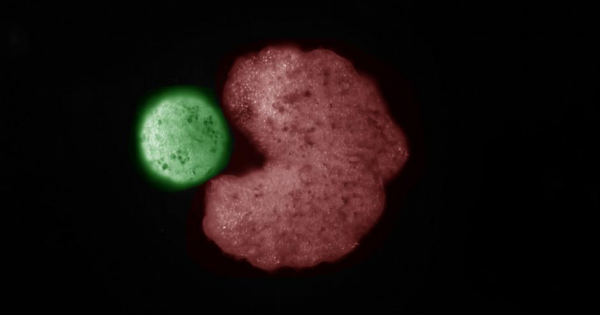Researchers in the United States found that xenobotsAnd Millimeter bio-bots created from frog cells, they have the ability to self-repeating across the Ribodoxin Biolgica with help Artificial Intelligence (AI). This is how the specialized magazine published it Proceedings of the National Academy of Sciences (PNAS).
The team from the universities of Vermont, Tufts and Harvard had already in 2020 presented the first xenobots assembled with frog cells. Now, scientists have documented it These hand-assembled, computer-designed organisms can swim in a petri dish, find individual cells, and collect hundreds of them.
Xenobot shaped like backman Keep these cells inside the “mouth” and can collect “children”, which become after a few days new xenobots, which can go out and find cells and build copies of them over and over again. If designed correctly, xenobots automatically reproduce automatically.
The embryonic cells in the frog xenopus laevis would develop into skin, but the team put them in a new context, to give them”A chance to reimagine your own multicellularityMichael Levine of Tufts University added, “Resulting in something completely different.
See: Tricks so your dog won’t pull on the leash when you take them for a walk
Although the cells contain the frog’s genome, the “Break free from becoming tadpoles, using their collective intelligence, flexibility, to do something amazing.”Lavigne total.
The lead author of the research, St. Krijman of the University of Vermont, explained that the original xenobot, by itself, is made up of about 3,000 cells that form a sphere:They can have children, but then the system usually dies. In fact, it is very difficult to get the system to continue playing.”

Thanks to Artificial intelligence, a evolutionary algorithm He was able to test billions of simulated body shapes — triangles, squares, pyramids, starfish — to find those that allow cells to be most efficient at the motion-based ‘kinetic’ cloning they orbit. New search.
Scientists asked the supercomputer how to adjust the initial shape of the parent and after months of work came up with several designs, including one thatHe looked like Pac-Man, which was the way xenobot, thus developing the biological part of the study.
Some people may interact with Interest in the concept of self-replicating biotechnologyBut the researchers made it clear that their goal is A better understanding of the characteristics of replication: “The world and technologies are changing rapidly. It is important for society as a whole that we study and understand how it works,” Bongard said.
The scientist also confirmed that these millimeter-sized living machines “They are fully contained in a laboratory, are easily extinguishable and have been checked by experts in ethics.Source: EFE

“Problem solver. Proud twitter specialist. Travel aficionado. Introvert. Coffee trailblazer. Professional zombie ninja. Extreme gamer.”




More Stories
With a surprise in the case: a strange cell phone from Nokia was introduced
PlayStation Stars: what it is, how it works and what it offers to its users | Sony | video games | tdex | revtli | the answers
t3n – Digital Pioneers | digital business magazine